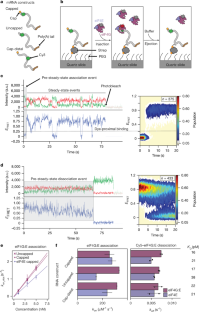2024-12-16 コロンビア大学
<関連情報>
- https://news.columbia.edu/news/new-finding-about-protein-motions-has-big-implications-drug-development
- https://www.nature.com/articles/s41586-024-08304-0
mRNAキャップ認識のメカニズム The mechanism of mRNA cap recognition
Riley C. Gentry,Nicholas A. Ide,Victoria M. Comunale,Erik W. Hartwick,Colin D. Kinz-Thompson &Ruben L. Gonzalez Jr
Nature Published:11 December 2024
DOI:https://doi.org/10.1038/s41586-024-08304-0

Abstract
During translation initiation, mRNA molecules must be identified and activated for loading into a ribosome1,2,3. In this rate-limiting step, the heterotrimeric protein eukaryotic initiation factor eIF4F must recognize and productively interact with the 7-methylguanosine cap at the 5′ end of the mRNA and subsequently activate the message1,2,3. Despite its fundamental, regulatory role in gene expression, the molecular events underlying cap recognition and mRNA activation remain unclear3. Here we generate a single-molecule fluorescence imaging system to examine the dynamics with which eIF4F discriminates productive and non-productive locations on full-length, native mRNA molecules. At the single-molecule level, we observe stochastic sampling of eIF4F along the length of the mRNA and identify allosteric communication between the eIF4F subunits that ultimately drive cap-recognition and subsequent activation of the message. Our experiments uncover functions for each subunit of eIF4F and we conclude by presenting a model for mRNA activation that precisely defines the composition of the activated message. This model provides a general framework for understanding how mRNA molecules may be discriminated from one another and how other RNA-binding proteins may control the efficiency of translation initiation.


